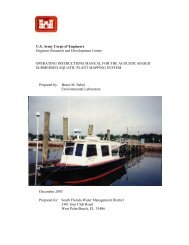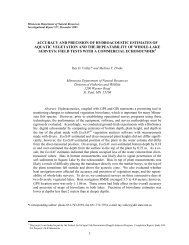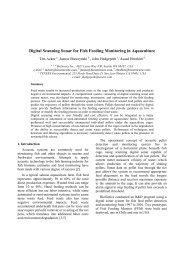Target Strength of Southern Resident Killer Whales ... - BioSonics, Inc
Target Strength of Southern Resident Killer Whales ... - BioSonics, Inc
Target Strength of Southern Resident Killer Whales ... - BioSonics, Inc
Create successful ePaper yourself
Turn your PDF publications into a flip-book with our unique Google optimized e-Paper software.
Code:46.2008-final-Feb9<br />
which equals 6.64 neper/m. For our analysis we chose to use values <strong>of</strong> <strong>of</strong> 4.45 neper/m at 67 kHz, 1.53<br />
neper/m at 23 kHz, and 13.28 neper/m at 200 kHz.<br />
The plane wave reflection coefficients for a three-layer model <strong>of</strong> water–blubber–lung at three different<br />
frequencies are shown in Figure 2 for an angle <strong>of</strong> incidence <strong>of</strong> 90 normal to the surface <strong>of</strong> the blubber. It<br />
also shows the variability in the reflection coefficient as a function <strong>of</strong> blubber thickness, which increases<br />
with frequency. Depending on the thickness <strong>of</strong> blubber layer, the difference in reflection coefficient<br />
between the frequencies <strong>of</strong> 67 kHz and 200 kHz could vary from 4 dB up to 15 dB. These reflection<br />
coefficient values can be used to estimate the TS <strong>of</strong> killer whales at 200 kHz.<br />
III.<br />
RESULTS<br />
A. Whale Behavior<br />
Figure 3 shows the averaged distance, depth, and swimming speed estimates for the killer whales<br />
observed a Lime Kiln Point. There were some unrealistic values for whale depth (above surface),<br />
possibly due uncertainty in the tilt angle <strong>of</strong> the split beam transducer in the horizontal direction or<br />
propagation effect such as multipath <strong>of</strong>f the ocean surface <strong>of</strong> the transmitter pulse and/or echo. Other than<br />
these observations, the trends in whale depth appear to be realistic given the visual observations <strong>of</strong> the<br />
whales. The whales were initially detected by the sonar at a range <strong>of</strong> about 100 m, swimming at a depth<br />
<strong>of</strong> about 2 or 3 m. They approached to within about 30 m from the sonar transducer at a depth <strong>of</strong> about 5<br />
m. At this range from the transducer they turned and swam away at a deeper depth. The killer whales<br />
were also observed to slow on their approach to the transducer then speed up after they turned and were<br />
swimming away from the transducer.<br />
9











